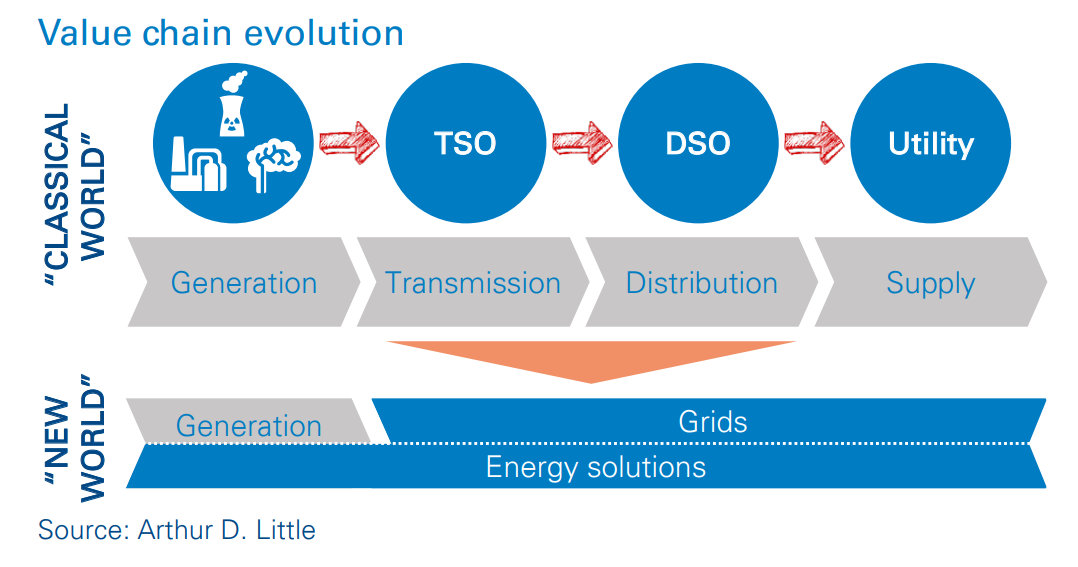
Within the energy ecosystem, the transition towards a more sustainable future mostly materializes through rapid increases in renewable energy sources, distributed generation and energy storage at large. The increasing share of intermittent generation sources is redefining the rules of the game – roles and accountability within the energy value chain are turned upside down. While the traditional role of the electricity Transmission System Operator (TSO) is more relevant than ever, fundamentally reshaping the future is equally high on the agenda, as it is triggered by game-changing factors such as new stakeholders, higher stress on the energy grid, digitalization, intermittence and flexibility. Here we share our learnings from recent Arthur D. Little projects.
New rules of the game within the energy ecosystem
Renewables and the increasing use of distributed generation sources are stretching the traditional energy grids, which were built to accommodate large central generation units and oneway distribution system operator (DSO) networks. Current prosumer reality has inverted the system, new actors have emerged (e.g., aggregators), geographies are increasingly interconnected, and all ecosystem stakeholders are rethinking their strategies. Specifically, a whole range of “energy solutions” are emerging along the value chain, forcing energy industry participants to rethink their traditional business models. In addition, central generation is transforming, with offshore wind and PV parks that mandate new “transmission highways”, as well as skyrocketing asset investments in energy grid backbones.

As a result, the traditional “linear” grid structure is evolving towards a “meshed” structure, and both TSOs and DSOs need to deal with new flexibility requirements and constraints. The need for a transformation at network level is reinforced by adoption of new technologies and use cases such as (large-scale and residential) batteries and electric vehicles (smart charging, vehicle-to-grid), as well as emergence of new electricity generation models such as virtual power plants (VPPs) and demand-side response (DSR). On the one hand, this challenges traditional network operator models, but on the other, it offers opportunities to existing and new players.
TSOs: Facilitate ongoing change, or lead the way?
Although the electricity system will continue to require a central transmission backbone network (central generation, whether it is conventional or renewable, is forecasted to remain predominant in the generation mix for the foreseeable future), the rise of intermittent, decentralized generation and micro-grids could lead to a decrease in reliance on transmission networks. For grid owners, this creates the risk of stranded assets and related regulated revenues. Multiple responses exist. Rather than mere defensive moves, TSOs have the opportunity to step out of their position in the value chain by leveraging innovative technologies and new use cases. There are multiple examples of how TSOs can transcend their “traditional regulated role”:
International expansion: e.g., Red Eléctrica invests in transmission assets in Latin America
- Entry into energy system services: e.g., Elia Group provides technical consultancy services through its independent EGI subsidiary, supporting other grid operators in a range of energy system services
- Deployment of new technologies in test-and-pilot setup: e.g., Terna and RTE invest in batteries in a range of applications for congested and imbalanced grid assets
- National Grid has developed a blockchain energy-trading platform and pushes EV fast-charging networks
- TenneT tests linking decentralized home storage solutions via blockchain to stabilize the grid
More opportunities will arise for TSOs willing to supplement the “classical” world with the emerging “transition” world, in which new priorities exist along four main axes: system operation, asset management, ecosystem facilitation and diversification (see below figure).This overview of opportunities stems from our implication in supporting TSOs in the definition and the development of their ambitions.



